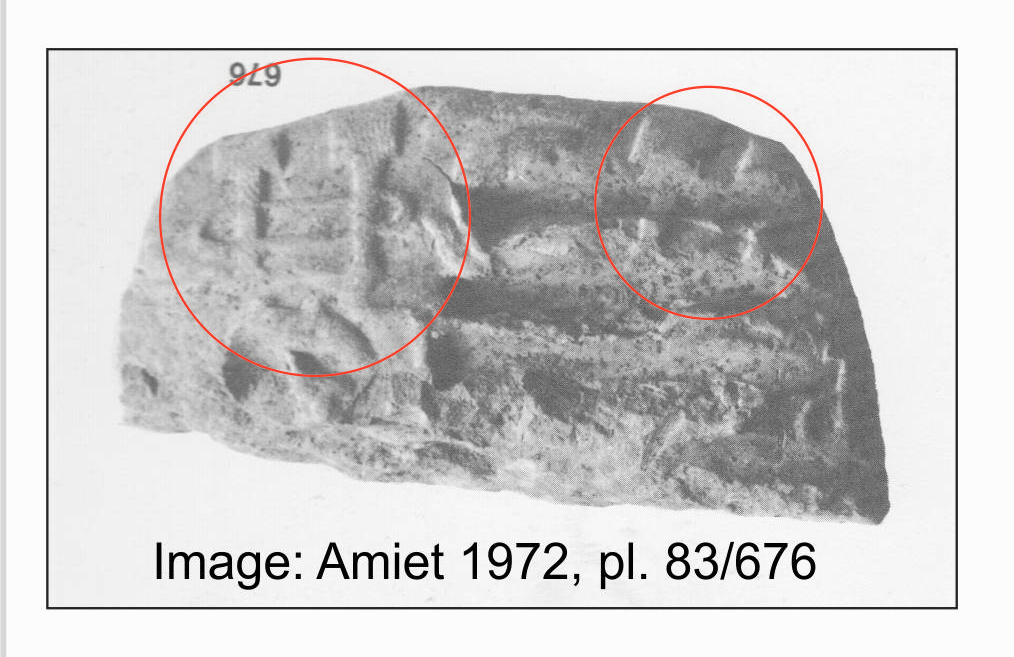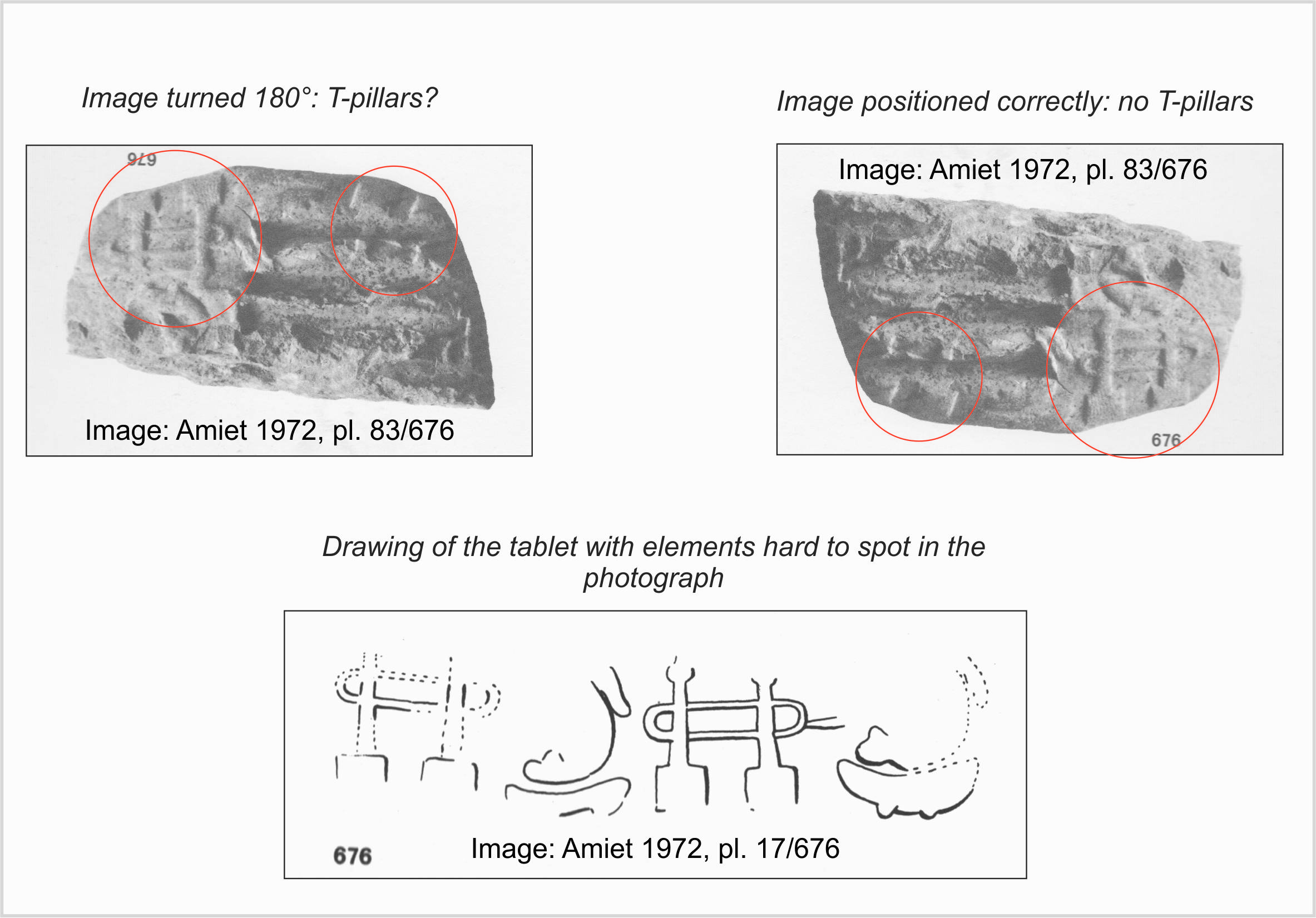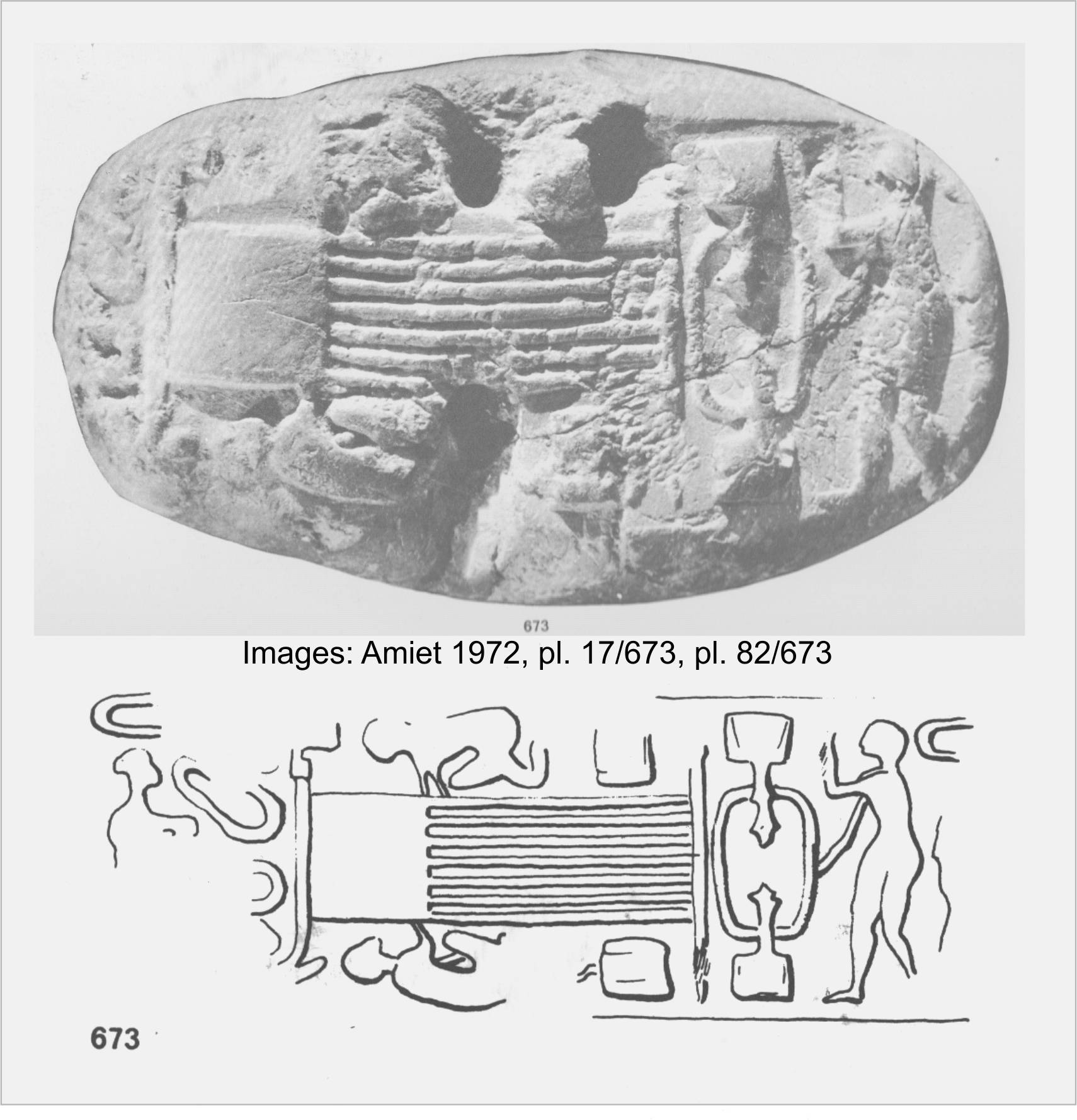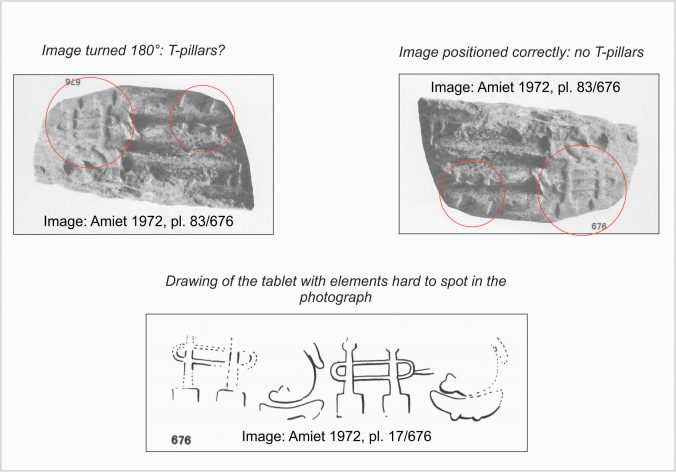Recently, I stumbled upon a blogpost by Graham Hancock [external link]. I was looking for something completely different, i.e. the “fallout” of the rather unfortunate meteor theory proposed by two researchers from Edinburgh in April. What I found however sent me off in a completely different direction. As it is a prime example how false interpretations of images arise, and how they could have been prevented right from the start, I thought I should write a few words about that blog post here.
In his short text, Hancock explains that an independent researcher, while browsing the images in the online database of the ‘Cuneiform Digital Library’ [external link], found a depiction of the enclosures of Göbekli Tepe with their iconic T-shaped pillars. On a seal impression from Susa, dating to the Uruk V period. The settlement phase Uruk V constitutes together with Uruk IV the Late Uruk Period. The details of the absolute chronology of this period, which sees the invention of writing (i.e. proto-cuneiform script starting from Uruk IVa) and the cylinder seal, is still under debate, but a general date between 3500-3100 BC seems to be safe. Göbekli Tepe is currently dated between c. 9500-8000 BC. So, there is some chronological and regional distance between the sites (Susa lies in nowadays Iran). “Nice mystery here”, to cite Hancock. But let’s have a critical look at the evidence, which is always a good idea when doing science.

Hancock´s post refers to a fragment of a cylinder seal impression, for which the ‘Cuneiform Digital Library’ database gives a scanned black and white photo and some background information, like the material (clay), the collection (Louvre, Paris) and the primary publication (MDP 43, 676). It is also clear that the image is rotated – most likely accidentally – by 180° compared to the original publication (the number is upside down). And there they are, the two T-shaped pillars encircled by an oval, shown two times. A perfect abstract depiction of a round building from Göbekli Tepe´s older layer, as it seems. Alright, the pillars inside the perimeter wall are missing. But who cares? It could be an abstracted depiction of something a few millennia older but apparently still very well known.
The seal impression is fragmentary and highly damaged. It is obvious that the original image was more complex. If we turn the image correctly and look a little closer, in front of the left Ts, which now do not resemble Ts anymore, there is an indication of some more depictions that are hard to identify on the b&w photograph. That is why finds were and mostly still are drawn in archaeology, and in any case described extensively. And where to find a drawing and description of the find? In MDP 43 of course.

I perfectly understand that this is the point at which those with a general interest in archaeology and browsing through an online database might be lost. MDP refers to the series “Mémoires de la Délégation Archéologique en Iran”. Why the “P”? Because the series was first called “Mémoires de la Délegation en Perse” and the abbreviation never changed. If we look the find up in volume 43 of this series, written by Pierre Amiet and dealing with “Glyptique Susienne”, the scene is described as “two figures sitting on the left, on curved seats, in front of apparatuses made up of two supports with square bases and an elongated oval element”. And the drawing of the sealing shows just that. The persons are touching this “oval element” with their hands. The publication has some more depictions of this kind on sealings, and at least some, such as MDP 43, nr. 673 or 674 are less fragmentary. It becomes immediately clear that we are not dealing with a depiction of T-shaped pillars, but of two supports with square feet at the bottom and a knob at the top, connected by an oval.
The depictions of people interacting with this “apparatus” are part of a group of sealings that shows people at work, and some of the images with the supports strongly hint in the direction of weaving (esp. nr. 673), the “oval” most probably being the depiction of a thread.

So, absolutely no “nice mystery here”. Just a misinterpretation of a highly fragmentary depiction. While dealing with prehistoric imagery things like that can happen quickly. Because the human brain interprets things in relation to former experiences and knowledge. In the case at hand, I have seen images of Göbekli Tepe´s round to oval enclosures with their iconic pair of monumental T-shaped pillars. Then I see two T-shapes on a scan of a b&w image of a highly-weathered fragment of a clay seal impression. And immediately make a connection between the two. Science starts when I challenge that superficial connection in the way described above with some simple questions that work not only in the case at hand:
- General chronological and cultural-historic reasoning: What is the cultural background of the artefact I am looking at and how old is it? How likely might it be that the people making it depict an object or a site millennia older and not something well-known to them?
- Iconographical reasoning: How was the way of depicting things in that particular period, may the shape I am looking at fit the way of representing certain devices / objects / things? What else might be depicted that perfectly fits the cultural background / everyday activities of the people making the artefact?
- Challenging the evidence / its documentation: Is the depiction fragmentary or hard to evaluate for other reasons? What kind of documentation is available to me? Does it allow me to fully comprehend what is depicted? Or do I need further information before I can make up my mind?
- Go to the sources. Archaeological artefacts, or artefacts similar to the one at hand are usually published somewhere, and these publications may hold further information and better images. It may be tricky to identify the available sources.
So, finally: Why not ask an archaeologist, some of us are nice people willing to help!
References
Pierre Amiet, Glyptique Susienne. Des origins à l´ époque des Perses Achéménides. Cachets, sceaux-cylindres et empreintes antiques découverts à Suse de 1913 à 1967. Mémoires de la Délégation Archéologique en Iran XLIII (Paris 1972).

I really love the fact that not only do you present your reasons for objecting to the interpretations, but your reasons are presented in such a way that we can all go and check the data. As always, fascinating work.
Great diatribe on using common sense questioning observations and artifacts! However people love the pat, so monetary interests not science drives delusional and wishful pseudo archaeology! Hope you and the team will find some time to run a blog on some of the “mysterious” findings 😉
The courteous way to go about this, bearing in mind that the bottom line is, “…Just a misinterpretation of a highly fragmentary depiction…”, is to write to GH, give him the information and any additional evidence, and await a response. So even if GH agrees and removes this piece of “evidence” from his arguments, it does not detract from the principal conclusion of the Sweatman/Tsikritsis paper. Graham Hancock is not their spokesperson, and I doubt he was solicited by them to be so.
Aligning both sets of authors with a “misinterpretation” by only one of them, is of course, a “straw man argument”. That’s not what science and in this instance archaeology, should be engaging in.
Equally, “money interests” drive all working people alike, be they GH, the archaeologists here or professional debunkers such as Jason Colavito – that I’m afraid is the world we live in. We are all free (although not necessarily!) to choose a particular path to that end. I guess that the seal represents not just people at work, but also how people “make a living”, and of course, whether they were indeed free to choose such a route is a part of socioeconomic investigation on the part of archaeologists and historians.
Having said this, I’m somewhat puzzled about the animal depictions, alongside the tools of this interpreted “trade”. Is there any consideration of this in “Mémoires de la Délegation en Perse”, or elsewhere?
Richard
Thanks for your advice on courteous behaviour in science, but please be assured that it is perfectly usual to exchange opinions via articles, be it on paper or electronically.
Further, where have I aligned “both sets of authors with a „misinterpretation“ by only one of them”? I just mentioned that I found the blogpost with the seal image while looking for something else.
Which animal depictions?
With respect, you open, “Recently, I stumbled upon a blogpost by Graham Hancock [external link]. I was looking for something completely different, i.e. the “fallout” of the rather unfortunate meteor theory proposed by two researchers from Edinburgh in April.
With respect to “linkage”:
The language is factual but also indicative of what your view is about the meteor theory, regarding which, elsewhere (covered by “fallout”) I have argued the issue as being of confirming the integrity of the astronomical interpretations, rather than the date of meteor strike conclusion and link to YD. Many articles and comments get automatically linked, not the least this issue, it already having been linked by sensational reporting in the media. The response, as in Chris P. Nokkentved’s comment, is evidence of how your presentation has been interpreted, whether you intended it or not. The use of the “unfortunate” and unscientific language used in the comment to your article, and this, five full months after your article was presented, makes it obvious how these links both materialise and interpretations and “judgements” persist.
With respect to your retort regarding “courtesy”:
All I meant was that you have not indicated, which I believe you should have done, whether, (before or after presenting your article – doesn’t really matter either way) you had alerted Graham Hancock to the fact. Because you stumbled on his doesn’t mean that he must necessarily stumble on yours. If you had notified him, and he had not responded then that becomes an act of discourtesy on his part. However, let’s not overplay this issue. Apologies if you have taken it personally, I was only making the point from a point of view of protocol, in the interests of proper scientific dialogue as part of presenting information to both scholarly and general audiences.
As regards “animals”:
I should have pointed specifically to the sketch as part of your 676 image. I thought that the description, “…two figures sitting on the left, on curved seats, in front of apparatuses made up of two supports with square bases and an elongated oval element…”, does not clearly fit anthropomorphic form, and could be interpreted otherwise as I have suggested. On 673 they are clearly of human form. Perhaps reference to a more detailed seal, if one exists, would clarify this?
Richard
Interesting how often I have to write this here: I have an opinion and I have the right to express it. You have an opinion and the right to express it as well. I have the right to disagree with you or any scientific hypothesis. You have the right to disagree with me and any scientific hypothesis.
If you share your thoughts publicly, you have to expect a public discussion. People participating in a such a discussion may not share your opinion.
No I don’t believe in archaeoastronomical evidence as it has been presented in the paper you mention. But the blogpost here really is about something else.
Thanks again for your advice on academic behavior and courtesy.
There really are no animals on the seal impressions shown here, what you see is the characteristic way of depicting humans in the respective period.
Thank you for the answer to the question about animals. The point being that depictions of animals of a tremendous variety at Gobekli Tepe has been mentioned in various dialogues, and what to me didn’t appear human – and the description quoted only referred to “figure” – is an interesting point to have in mind in the future. I particularly refer to your conclusion, which I first checked in case my memory failed me, of “…not every depiction is ‘readable’ beyond doubt…”. So your confirmation about there being no doubt in this instance is welcome – although I still can’t personally say that I would be able to recognise any doubtful symbol such as these, as human!
As to opinions, of course! But the point is that the comment made by Chris P. Nokkentved is not courteous and clearly unscientific. Of course you have every right not to comment on it, perhaps as it did not use abusive words, as I had every right to do so because I thought it was abusive, nonetheless. And I guess he wished it to apply to a wider group of researchers than Graham Hancock alone.
I am the person who suggested a link between the Uruk IV tablet image and the stones of Gobekli Tepe to Graham Hancock. He has kindly allowed me a slot on the Articles section of his website where you will find my response to the above post:
https://grahamhancock.com/dainesm3/
Madeleine Daines